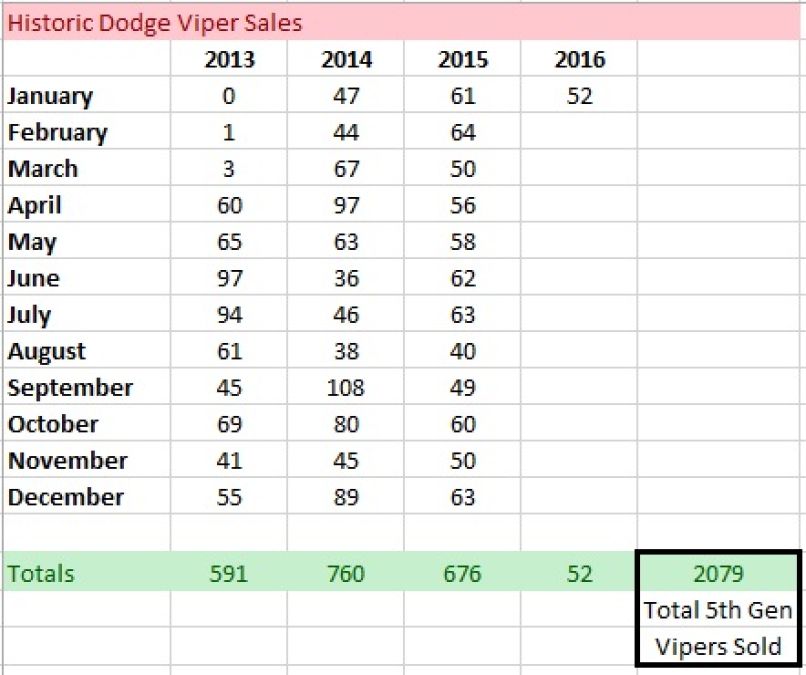When the Dodge Viper first hit the market early in 2013, it was rumored that the company was looking to keep production numbers of the hand-built supercar in the range of 1,000 units per year, but the company assured enthusiasts that they could increase sales to 1,500 or 2,000 units if the need arose. Sadly, the need never arose and while Viper sales have been fairly steady over the past three years, the numbers have not been strong enough to keep the Viper alive and because of that – the modern Viper will be gone after 2017.
The First Year
When the Dodge Viper began reaching owners in early 2013, it did so at a very slow rate. In February, one Viper was delivered and 3 more reached owners in March, but starting in April 2013, the Viper began selling a rate that we all expected to see climb as the quality control process smoothed out over time. In April 2012, 60 Vipers were shipped followed by 67 in May and 97 in June. When those strong June sales were followed up with 94 units sold in July, it looked like the Viper was finally hitting its stride. After all, selling more than 90 Vipers per month would allow the company to exceed their annual production expectations – but that wouldn’t become a problem.
After July, sales numbers dropped to 65 units in August then just 45 in September, back up to 69 in October and back down to 41 in November before finishing the 2012 calendar year with 55 supercars sold in December.
In total, Chrysler sold 591 examples of the Viper in that first year, with expectations of selling even more in 2014.
Sales Remain Slow, Prices Fall
2014 didn’t start off great for the Dodge Viper, but January isn’t exactly ideal supercar weather due to the frigid temperatures and snow-covered roads in many parts of the country. Just 47 Vipers were sold in January and 44 were sold in February, but things were looking up in March when the company sold 67 V10 powered beasts. Come April 2014, it looked like the Viper was starting to build momentum once again when 97 units were sold, but when sales dropped to 63 units in May and 36 in June, it was clear that the numbers just weren’t going to remaining consistently strong.
After Dodge sold only 46 Vipers in July and 38 in August, the Chrysler Group announced a $15,000 price cut that was followed by a spike in sales of 108 Vipers in September – which was and still is a record for the 5th gen supercar. Sales dropped a bit to 80 units in October followed by just 45 units in November and with a strong rebound to end the year, Dodge sold 89 Vipers in December 2014.
In total, Dodge sold 760 Vipers during the 2014 calendar year. Unfortunately, that was as good as it would get for the Viper, as sales numbers dropped back to early-2014 numbers throughout most of 2015.
2015, 2016 and Beyond
The Viper started 2015 as strong as any year, with 61 units sold in January and 64 in February, but when the numbers dropped into the 40s and 50s through the middle of the year – Viper sales would end up averaging just 56 units per month in 2015. Those 64 units sold in February ended up being the best month of 2015 end the numbers bottomed out in August when the company sold just 40 Vipers. In total, Dodge sold 676 units in 2015, which is down by almost 100 units from the year before.
Finally, Viper numbers for 2016 started off a bit short of 2015, with 52 Dodge supercars sold last month. When you add together the totals from 2013, 2014, 2015 and 2016, we get a total of 2,079 5th gen Vipers sold in three full years of deliveries.
While the mighty Viper hasn’t sold very well, we learned recently that the inability to fit side curtain airbags played a bigger part in the demise of the modern Viper. Should that be true, we can expect to see a new Viper down the road.














Comments
This won't help either!
Permalink
This won't help either!
January 2016
Dealer Service Instructions for:
Customer Satisfaction Notification R28/R29
Engine Oil Contamination and Consumption
2013-2014 (ZD) Dodge Viper
The engine cylinder block on about 1,100 of the above vehicles may have been contaminated with abrasive debris.
Under rare conditions during high-speed right-hand cornering when the engine is at light throttle and high RPM, engine oil can be forced into the Make Up Air hose, resulting in unintended oil consumption.
Customer Satisfaction Notification R28/R29
Engine Oil Contamination and Consumption Page 2
To address the R28 portion of this CSN, the oil contamination issue, the engine oil,
oil filter and air filter must be changed then the oil filter must be sent to FCA for
analysis.
If FCA’s analysis of the oil filter is positive for debris, the dealer will contact the
customer to schedule replacement of the engine and related oil cooler components.
If a new engine is not required, the dealer will contact the customer to inform them
that they do not need to return to the dealership.
To address R29 portion of this CSN, the oil consumption issue, an updated oil
management system must be installed which includes a new valve cover assembly
with a relocated make up air (MUA) fitting and new baffle.